ikfoundation.org
The IK Foundation
Promoting Natural & Cultural History
Since 1988


A STUDY OF TWO HAND-COLOURED FASHION DRAWINGS FROM 1792
– and Contemporary Garments
The repeated regulations in 18th century Sweden, which were related to “sumptuousness and excess,” were deciding factors in how people of different social strata were able to dress, making the choice of textile material dependent not only on each individual’s financial status. A complex set of rules was dictated; when it concerned textiles, it first and foremost included various restrictions on silks, laces, voluminous types of clothes, trains on dresses, etc luxury items. Many of these laws were still a reality in the 1790s, a period central for this brief study focusing on two beautifully preserved hand-coloured drawings. The fashion depictions demonstrating wealthy or aristocratic individuals’ way of dressing are accompanied by a few other items – a miniature portrait, a printed calico fabric and a pair of machine-knitted stockings – all of the contemporary date and with Swedish connections.
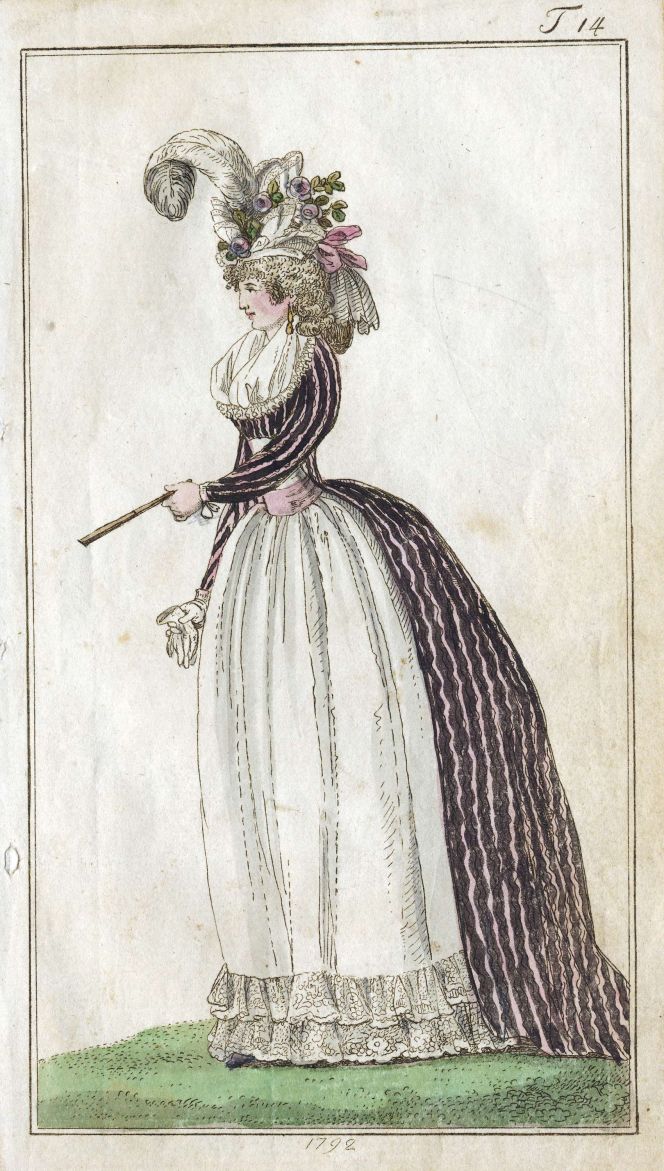 Female fashion in coloured drawing dated 1792. Noted at the back in translation from Swedish: Made by C H Fürst in Stockholm’. (Courtesy of: The Nordic Museum NMA.0041098).
Female fashion in coloured drawing dated 1792. Noted at the back in translation from Swedish: Made by C H Fürst in Stockholm’. (Courtesy of: The Nordic Museum NMA.0041098).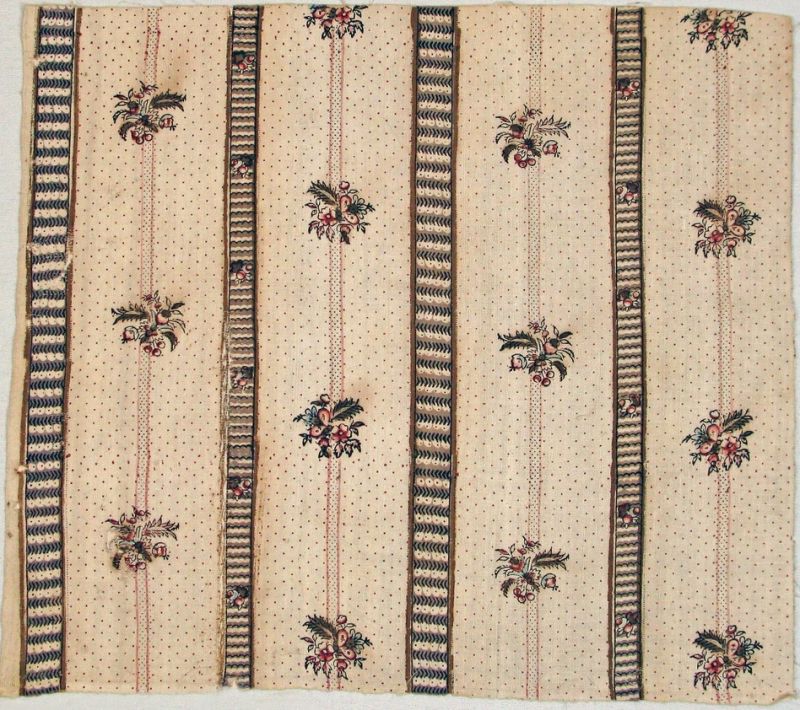 Even if it is difficult to be certain of used/intended fabric on the fashion drawing of the young lady’s dress, one likely possibility was printed calico. This unique piece of fabric may be a good contemporary comparison. Furthermore according to information on the catalogue card, the calico was made in Stockholm too, and with the signature Abraham & Isac De Broen in 1791. The De Broen family had started up as printers of calicoes and linens more than half a century earlier in the capital, but even if their name still was in use as a token of quality in the late 18th century, the manufactory was by then in the hands of other owners. (Courtesy of: The Nordic Museum NM.0241636 & Henschen pp 30-32).
Even if it is difficult to be certain of used/intended fabric on the fashion drawing of the young lady’s dress, one likely possibility was printed calico. This unique piece of fabric may be a good contemporary comparison. Furthermore according to information on the catalogue card, the calico was made in Stockholm too, and with the signature Abraham & Isac De Broen in 1791. The De Broen family had started up as printers of calicoes and linens more than half a century earlier in the capital, but even if their name still was in use as a token of quality in the late 18th century, the manufactory was by then in the hands of other owners. (Courtesy of: The Nordic Museum NM.0241636 & Henschen pp 30-32).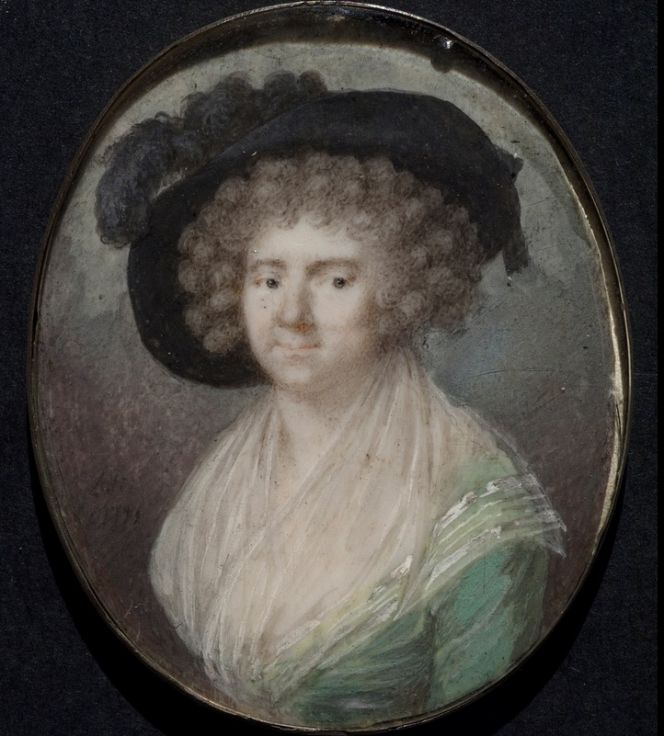 This contemporary miniature painting demonstrates that these depictions were not necessarily portraits of a young person – as was customary on fashion plates/drawings. Here we see the 54 year old Katarina Maria Jacobsson (1737-1792, née Ekerman) in 1791. However, the style of fashion is similar to the younger woman’s outfit above, even if somewhat more modest with a black hat and plain green dress. (Courtesy of: The Nordic Museum NM.0081679).
This contemporary miniature painting demonstrates that these depictions were not necessarily portraits of a young person – as was customary on fashion plates/drawings. Here we see the 54 year old Katarina Maria Jacobsson (1737-1792, née Ekerman) in 1791. However, the style of fashion is similar to the younger woman’s outfit above, even if somewhat more modest with a black hat and plain green dress. (Courtesy of: The Nordic Museum NM.0081679).A fashion illustration could be just a coloured drawing existing in one unique copy as these two discussed illustrations drawn by C H Fürst in Stockholm, but depictions like these were often printed to reach wider circles. In the late 18th century these type of prints – as sheets or as part of journals or almanacks – were primarily imported to Sweden by printers or bookshops who sold such goods, or purchased by Swedes on journeys from England, Germany or France. The art historian Patrik Steorn emphasises that prints of fashion had various purposes: to inspire increased consumption, to document a particular style of dress, to spread fashion ideas among friends or just be a decorative feature in one's possession. Furthermore, it was not unusual for Swedish newspapers in the late 18th century to copy French fashion illustrations, due to the increasing interest in Stockholm and other cities for the latest clothes’ designs.
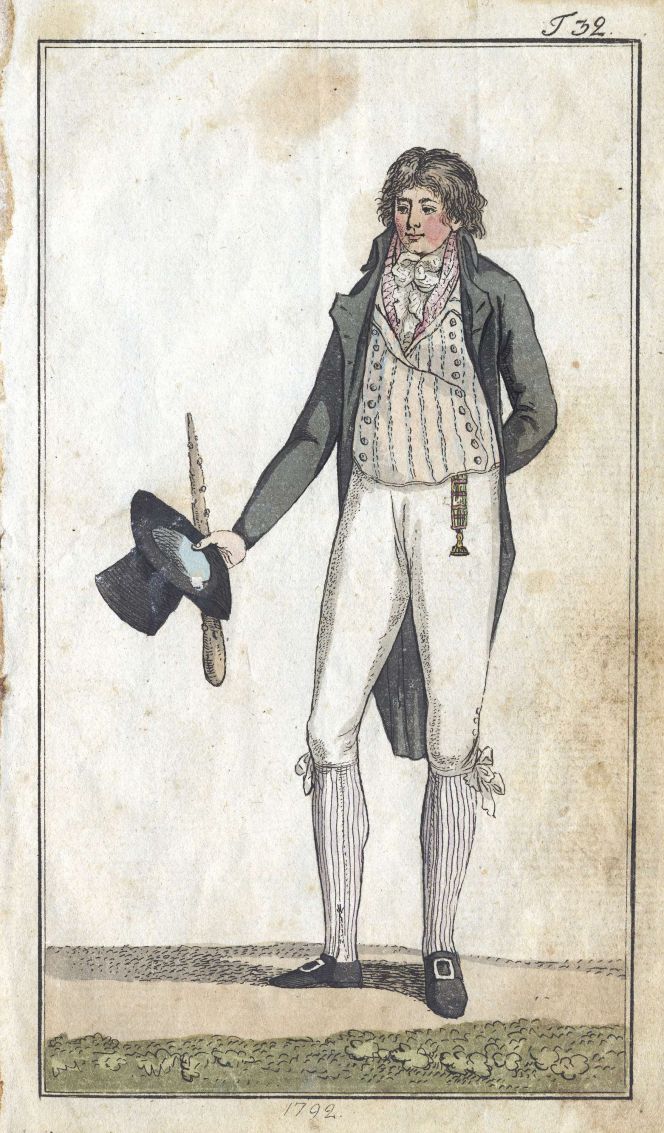 Male fashion in coloured drawing dated 1792. Noted at the back in translation from Swedish: ‘Made by C H Fürst in Stockholm’. (Courtesy of: The Nordic Museum NMA.0041099).
Male fashion in coloured drawing dated 1792. Noted at the back in translation from Swedish: ‘Made by C H Fürst in Stockholm’. (Courtesy of: The Nordic Museum NMA.0041099).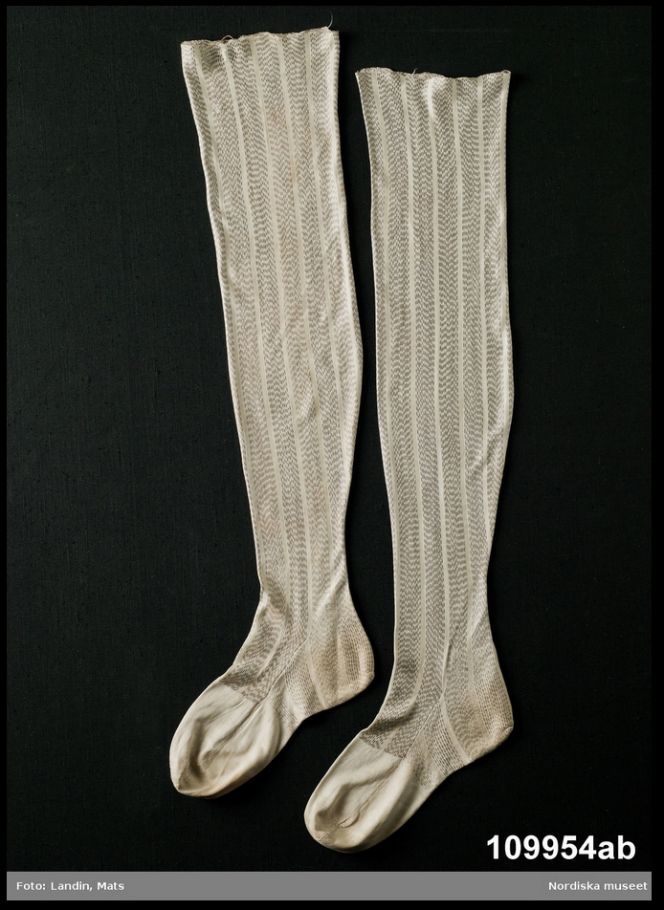 It is rather rare to find comparable clothing to 18th century fashion drawings, but these fine silk stockings are one such exception which looks almost identical in design, shape as well as material. These machine knitted long stockings of silk, may also be compared to some men’s fashion in printed German journals from 1789 and 1794. These two journals – Journal des Luxus und der Moden (June 1789) and Journal für Fabrik, Manufactur, Handlung und Mode (February 1794) – have been studied by Lena Rangström in her research of male fashion from this period (pp. 237-238). (Courtesy of: The Nordic Museum NM.0109954A-B).
It is rather rare to find comparable clothing to 18th century fashion drawings, but these fine silk stockings are one such exception which looks almost identical in design, shape as well as material. These machine knitted long stockings of silk, may also be compared to some men’s fashion in printed German journals from 1789 and 1794. These two journals – Journal des Luxus und der Moden (June 1789) and Journal für Fabrik, Manufactur, Handlung und Mode (February 1794) – have been studied by Lena Rangström in her research of male fashion from this period (pp. 237-238). (Courtesy of: The Nordic Museum NM.0109954A-B).Sources:
- DigitaltMuseum (Objects: Two Fashion drawings in 1792, miniature painting in 1791, fabric sample from 1791 and late 18th century man’s stockings. Information on respective catalogue cards).
- Hansen, Viveka, Textilia Linnaeana – Global 18th-century Textile Traditions & Trade, London 2017 (research material, pre-publishing).
- Henschen, Ingegerd, Kattun tryck – svenskt tygtryck 1720-1850, Stockholm 1992.
- Rangström, Lena, Modelejon Manligt Mode – 1500-tal 1600-tal 1700-tal, Stockholm 2002.
- Steorn, Patrik, ‘Modebilder i det svenska 1700-talets trycksakskultur’, Biblis 69, 2015, pp. 10-18.
Essays
The iTEXTILIS is a division of The IK Workshop Society – a global and unique forum for all those interested in Natural & Cultural History from a textile Perspective.
Open Access essays, licensed under Creative Commons and freely accessible, by Textile historian Viveka Hansen, aim to integrate her current research, printed monographs, and earlier projects dating back to the late 1980s. Some essays feature rare archive material originally published in other languages, now available in English for the first time, revealing aspects of history that were previously little known outside northern European countries. Her work also explores various topics, including the textile trade, material culture, cloth manufacturing, fashion, natural dyeing, and the intriguing world of early travelling naturalists – such as the "Linnaean network" – viewed through a global historical lens.
For regular updates and to fully utilise iTEXTILIS' features, we recommend subscribing to our newsletter, iMESSENGER.
been copied to your clipboard




– a truly European organisation since 1988
Legal issues | Forget me | and much more...
You are welcome to use the information and knowledge from
The IK Workshop Society, as long as you follow a few simple rules.
LEARN MORE & I AGREE







